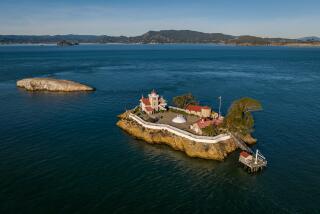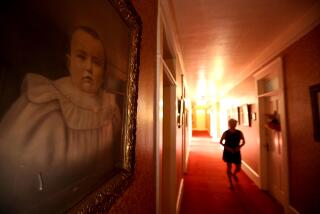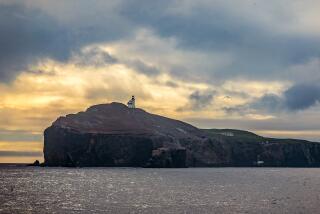Florida’s Cedar Key Has Everything But Glitz
- Share via
CEDAR KEY, Fla. — This may be the only place in the world where crowds gather to whoop it up while the Sharks rip into any and all comers.
The Sharks, as it happens, are the local high school’s athletic teams. If that sounds a little strange, just wait.
There is an island ruled by a ghost, an ancient Indian chief’s curse, a haunted hotel, a mysterious massacre and, well, we’re getting ahead of ourselves. Back to the beginning.
First of all, Cedar Key is not part of the Keys at all. At least not the Keys you are thinking of--the Keys West, Largo and Marathon, the glitzy, touristy Keys.
Instead, look north of Tampa, where Cedar Key lies basking at the southern tip of Florida’s so-called Redneck Riviera.
This isolated little community at the tail end of Route 24 embodies the Sunshine State the way it used to be, long before vacationing snowbirds started nesting on every available patch of sand.
If you have never heard of Cedar Key, there is a reason: There is nothing here. No neon. No big hotels. No condo sprawls. No golf course. Not even a movie theater. And that is just how folks like it.
This once-upon-a-time town has turned its back to the mainland and gazes staunchly out to sea, plucking a grudging living from dark, salty gulf waters bounded by the Suwannee and Waccasasse rivers.
Flat-bottomed bird-dog boats cull the shallows looking for oysters, mullets and crab. Farther out, fishermen hunt for pompano or anything else they can catch. Not much else happens.
“There’s nothin’ exciting goin’ on,” says longtime resident Lindon Lindsey as he gazes out over the town’s main drag.
As Lindsey rambles, the sun smolders through the salty mists that rise with the dawn.
A rumpled-looking Irish setter plays king of the road and saunters past a row of tin-roofed, weather-beaten pastel houses. Osprey nests crown the occasional telephone pole like oversized beachcombers’ hats.
Out on the swaybacked fishing pier, a few lazy pelicans hustle handouts from early-bird anglers.
“It’s just a quiet place,” Lindsey says.
Tranquil and timeless, Cedar Key has plenty of eye appeal. It’s long been a favorite haunt of artists, who find pleasing compositions almost anywhere their eye comes to rest. Writers, too, have been drawn by the town’s soothing solitude.
It was not always so somnolent in Cedar Key. In fact, this was once one of the busiest burgs in Florida.
Around the turn of the century, the industrial buzz of fishing, boat-building, sponging and distilling turpentine lured more than 2,000 residents to the self-proclaimed “Venice of the South.” Gunfights, gambling, saloons--the town had it all.
Fish caught offshore were sold fresh in New York City’s Fulton Fish Market. The now-rare cedars that gave their name to the key were cut, milled and shipped off to be turned into Eagle and Farber pencils.
The pencil industry made Cedar Key such a bustling port that Union forces deemed it a priority to capture the town during the Civil War.
Then a hurricane wiped out the mills. Some say the 1896 storm was the legacy of a Timucuan Indian chief who, along with his tribe, was captured by white men and imprisoned on nearby Seahorse Key.
The regal, tattooed chief nixed resettlement at a distant reservation and was put to death--but not before he cursed Cedar Key, entreating nature to visit destruction upon the island whenever development-happy white men ran amok.
At least one local believes that same curse still protects the islands from being paved, malled and condoed like the rest of Florida.
Cedar Key is not one island. It is an archipelago--a cluster of islands including Deadman’s Key, Rattlesnake Island and Atsena Otie. The island where most folks live--nearly all the other islets are protected reserves--is actually Way Key, though everybody knows it as Cedar Key.
One of these islands--Seahorse Key--is rumored to contain treasure buried by the pirate Jean LaFitte. The headless ghost of his henchman, Pierre LeBlanc, reportedly still patrols the island on horseback, although he long ago lost his noggin to someone bent on stealing the loot.
Nowadays islanders tend to their own business. But beneath the placid surface, dark currents whorl.
In its most harmless form, that dark side is manifest in a massive scrub oak pushing through the pavement in the middle of Third Street. An aging cracker with a shotgun straddling his lap once protected the tree from harm during work on the town’s roads.
Much darker is the story of a massacre in the 1920s, when the town’s whites reportedly wiped out its blacks. Today only one black family lives on Cedar Key.
Despite past transgressions, Cedar Key dwellers today say that they welcome visitors. Though the town displays a total lack of pretense, there are a few comfortable places to stay, a craft shop or three, and enough good restaurants to lure a constant trickle of visitors.
On weekends the place is sometimes packed, and Clydesdale-drawn wagons haul tourists around the little grid of streets masquerading as a downtown. Each spring an art show balloons the population for a few days.
When the crowds swarm in, some descend on the Island Hotel, a lumbering hulk of a place built 140 years ago.
It is the kind of hotel you would see in the Caribbean 40 years ago (or in Belize today), complete with sagging, wraparound veranda, fading murals, sloping floors and mosquito nets suspended over the beds. Its walls, like many on Cedar Key, are built of tabby, a mix of cement and crushed oyster shells.
In spite of--or perhaps because of--its eccentricity, the hotel’s guest list includes statesman Dag Hammarskjold, actor Richard Boone, author Pearl S. Buck (who drove up in a bright yellow Cord) and Florida’s unofficial folk hero, Jimmy Buffett, who gave an impromptu three-hour concert on the veranda.
To some, the hotel has a spooky air. More than one guest has suggested the owner schedule a seance . . . and soon. Spirits walk its halls, they say.
Some visitors find the whole town spooky. There is no denying it might make a good setting for a Stephen King story.
Boarded-up buildings, dark trails through trees festooned with mossy garlands, the secretive whispers of rustling palms and an inescapable end-of-the-road aura imbue the town with a vaguely sinister air. It is not Fort Lauderdale, that is for sure.
But for exiles from theme-park Florida, outdoors people, artists, writers and seekers of solitude, this is paradise.
Getting More Information
For more information: Contact the Cedar Key Area Chamber of Commerce, P.O. Box 610, Cedar Key, Fla. 32625, (904) 543-5600, or the Florida Department of Commerce, Bureau of International Tourism, Collins Building, 107 W. Gaines St., Suite 530, Tallahassee, Fla. 32399--2000, (904) 488-4141.
More to Read
Sign up for The Wild
We’ll help you find the best places to hike, bike and run, as well as the perfect silent spots for meditation and yoga.
You may occasionally receive promotional content from the Los Angeles Times.






